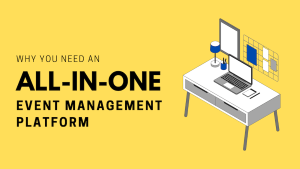Since the dawn of email, its main shortcoming has been that it’s rarely concise or categorizable. Naturally, this poses a considerable challenge when coordinating conferences in which minute detail and adherence to regulations are of utmost importance for a successful outcome. This issue is primarily a consequence of a few ways one can immediately obtain all their required information from a quick scan of an email.
Shortcomings of email correspondence for abstract management
Submitting proposals over email is another roadblock to the smooth running of research conferences. Often the candidate/researchers will not be aware of the criteria their proposal must meet, leading to frustrating confusion, delayals, and unnecessarily increased workload.
A possible solution to this common problem is to inform all potential participants of the expected due dates, word counts, etc. However, adherence to these guidelines is challenging to track, considering the sheer volume of emails involved. There is also the added step of forwarding the email contents to prospective reviewers for reviewal. In turn, these reviews would be submitted by email. Thus manual pairing of reviews to the proposal would be necessary. As expected, an email-based correspondence platform for a conference would require considerable admin and extra hours of work/maintenance.
A more robust solution? Hint: Online Abstract Management Software
Overcoming this cumbersome problem is no mean feat. It would require that email correspondence be removed entirely from the picture. An elaborate organizational platform is to be sourced and put to efficient use.
Abstract management systems effortlessly tick all of the aforementioned boxes. Historically, abstract management has been a tedious, time-consuming manual process that requires the precise coordination of all participants involved. A growing number of organizations/workplaces have turned towards web-based abstract management software to streamline and simplify the process.
What is an abstract management system?
An abstract management software can receive, preserve, and sort abstracts and proposals from authors. The abstracts can subsequently be meted out to selected reviewers for appropriate reviews. Most abstract management systems also have an efficient grading/evaluation system to facilitate the reviewing process while offering authors a clear overall idea of how their abstract was received.
Everything from submission to reviewing abstracts is completed within the confines of the abstract management platform. Administrators gain a bird’s eye view of the submission and review process and can also effectively categorize, analyze, and manage all submitted proposals. Authors and reviewers can also gain a broad overview of their submissions and activity on the platform. This beneficial factor of abstract management systems is often achieved through an account-based system in which an author or reviewer can log their personal details.
Optimized abstract submission system
However, the optimized submission system is perhaps the most revolutionary feature of online abstract management. Earlier, it was impossible for organizers to allow only those submissions matching specific criteria; the abstract management software has made it possible. Abstract management systems allow administrators to set limitations to submissions through several configurable options. These options include but are not limited to the number of co-authors on a paper, maximum submission intake, start/end submission due dates, and abstract word limit. Through this grouped system, an administrator can ensure that all submissions directly meet the expected requirements while informing the authors of what guidelines they must adhere to.
Furthermore, authors are usually offered the choice to submit their abstracts under various headings that apply to their abstract contents. Whether the abstract is depicted in poster form, conveyed orally, presented as a presentation, or a mixture of all available formats. This innovation means that an abstract can be submitted in Microsoft Word, Excel, PDF form. If graphs or diagrams are not applicable, the abstract can usually be introduced directly into the system in plain text form.
Thanks to this organized system, abstracts can easily be filtered through the selection of custom data points. Authors and co-authors of proposals/abstracts can also be automatically notified of their accepted or rejected status proposals.
Efficient Evaluation & Payment System for Abstracts
Through this optimized and highly-organized review process, conference organizers are then able to aptly select which category of reviewer to direct the abstract to for review.
This fully customizable system allows for stringent feedback or rebuttal management by which the administrator oversees correspondence between authors and reviewers. One of the main variables of this system is choosing between double-blind testing, allowing for anonymity and objectivity.
Concerning payment, abstract management software is capable of transferring the entire financial exchange process online. Authors can both pay submission fees and receive compensation for submission through online bank accounts, PayPal, and other means.
In short, abstract management systems are entirely customizable online submission and review platforms by which conference organizers/managers can oversee the conference participant’s workflow.
Abstract Management System: features to look for
So, why should conference managers employ the use of web-based abstract management systems over more traditional organizational systems? Is there a reason why conference management is shifting online? Here are a few features of online abstract management systems that could influence the trend towards adopting the novel systems.
- Accessibility – Submit abstracts from anywhere
- Improve the quality of event content/offerings
- Monitor progress and workflow in real-time
- Effortless analysis of data through preset reports
- Ease of communication between reviewers and applicants
- Increase abstract submissions
- Reduce administrative costs
- Customization to suit every conference’s needs
- Option of cloud storage or auto-saving to ensure the integrity of data
- Output of data significantly simplified e.g., PDF, spreadsheet, URL
- Comprehensive abstract assignment & review system
Conference management is a multifaceted undertaking requiring a number of variables to fall into place. The administration, organizational, and communicative demand tends to be immense and, if not handled properly, can easily result in lower-quality conference outcomes. Particularly if on a large-scale, this cannot be left to email or paper correspondence, and online system is preferred.
Web-based abstract management systems incorporate customizable parameters with organization and efficiency – a mix rarely achieved by alternative approaches. Conference managers can act as the immediate overseer and arbiter of the entire conference workflow allowing for optimized results and increased participant/reviewer satisfaction. It appears that abstract management systems will be a dominant key player in future conference management.
Related Searches
- Still Accepting Abstract Submissions Through Email?
- Guide for Writing Conference Abstracts
- Checklist for Successful Abstract Launch
- Abstract Book Builder for Conferences
- AI Quality Checks & Plagiarism Detection for Abstracts
- Advanced Auto-Assignment in Abstract Management
- Simple Bulk Download in Abstract Management
- Step-by-Step Guide to Setting Up Peer Review for Abstracts
- Complete Guide to Writing Abstracts [PDF]
- How to write Abstract for a Conference
- Collect Abstract Submissions Fees Online
- How to Submit Abstracts using Abstract Management System






